/groups/physics/search/index.rss?tag=hotlist/groups/physics/search/?tag=hotWhat’s HotHotListHot!?tag=hot0/groups/physics/sidebar/HotListNo items tagged with hot.hot/groups/physics/search/index.rss?sort=modifiedDate&kind=all&sortDirection=reverse&excludePages=wiki/welcomelist/groups/physics/search/?sort=modifiedDate&kind=all&sortDirection=reverse&excludePages=wiki/welcomeRecent ChangesRecentChangesListUpdates?sort=modifiedDate&kind=all&sortDirection=reverse&excludePages=wiki/welcome0/groups/physics/sidebar/RecentChangesListmodifiedDateallRecent ChangesRecentChangesListUpdateswiki/welcomeNo recent changes.reverse5search
First, let's start with the radio from last chapter:
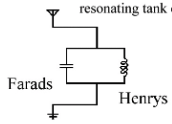
Recall that this created an oscillating electric current between the L and C. Recall also that this mirrored a similar mass/spring system. Make sure to keep these in mind.
Now, try this:

Play with the frequency of the charge up and down the antenna, and notice how the fields around the antenna change
Check out this image of current in the wire/antenna:
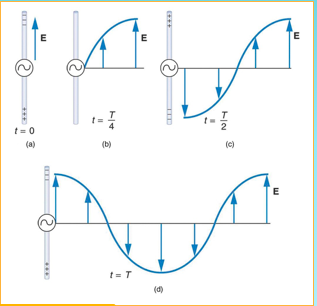
Notice the sine wave pattern of the electric current.
Now for the field this creates:

Make sure to verify this using your right hand rule.
Notice in the middle frame how the B field is always 90° to the E field.
This is the hardest part of EMR to understand...
Note also that Maxwell found this:

Connecting electricity (the Eo part) with magnetism (the uo part). This is true for all EMR from light to radio waves (not sound or earthquakes though, they are not EMR, but are compression waves in a medium)
Since the E field creates the B field which creates the E field, Light and other EMR needs no medium, but the speed of this radiation depends on Eo and uo for that medium, so the speed of light IN A VACUUM is about 3 ee8 m/s
One more tough bit: E/B =c
Think this over: if the fields are creating each other, then their ratio has to remain constant (look at the picture above).
OK, NOW FOR THE FUN PART.....
Recall from your study of waves that:
Velocity = frequency x wavelength
or in the case of light and EMR:

Easy, now we can calculate the wavelength of any EMR wave.
Example: pick your favorite radio station. Find the frequency (FM is fun). Your car antenna should be 1/4 of the wavelength to receive this station best. How long should your car antenna be?
Repeat this with a frequency of 2.4 gHz. What will be the wavelength? Why is this interesting?
The EMR spectrum (VERY interesting):
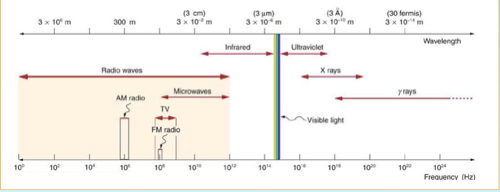
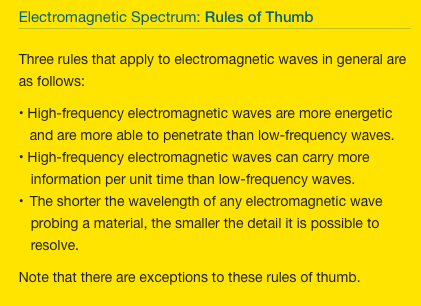
Keep in mind that as frequency increases, wavelength decreases (their product is a constant, c).
Keep in mind also that higher frequencies have higher energies (you have not learned this yet, but compare IR light to UV light-which one will give you a sunburn).
Also: the higher the frequency, the less the impact of diffraction (travel around corners), so 2.4 gHz needs to be line of sight, while HF radio (14 mHz) can bend a bit.
3 ISM bands: 900 mHz, 2.4 gHz, 5.8 gHz
Radio is a cool example of this: FM radio is frequency modulation:
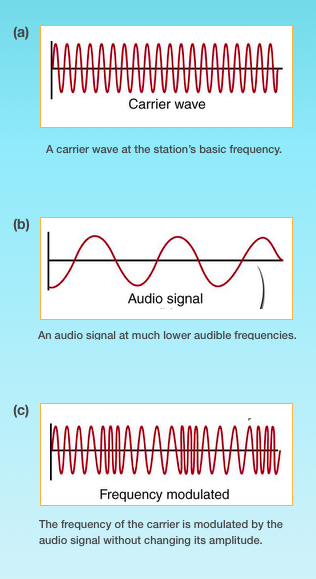
While AM radio is amplitude modulation:

Interestingly, the signals from your ear to your brain are also FM. Why?
More bits:
Intensity is not power, but they are related. You may find this with other wave phenomena like earthquakes. In the case of EMR, we use these formulae:
 for the E field version
for the E field versionand

for the B field version,
and combined:

While you may never see these on an AP exam, if you go into physics in college, they will certainly show up. Notice where Eo and uo show up in each.
Fun with spectra:
ELF
Microwaves (ovens, ISM band wifi)
Radar (square wave pulses)
IR
Visible
UV, ozone layer, three types of UV
X-rays
cosmic rays
Each of these travels at about 3 ee 8 m/s.
Look up the blue glow in nuclear reactors, called Cherenkov radiation...
Lab:
Determine the efficiency of the microwave oven.
Look up Watts
Heat a mass of water in an insulated cup
Measure temperature change
Calculate energy captured as heat
Calculate energy expended
Calculate efficiency
Simulations:




Comments